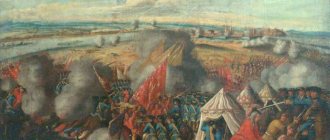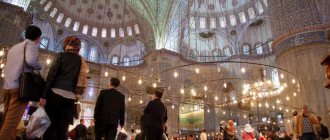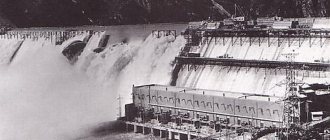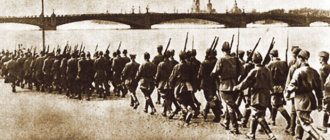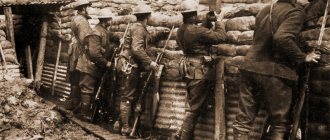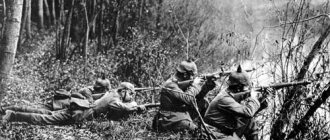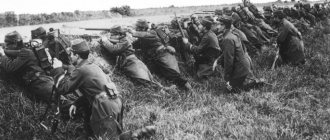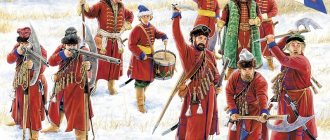Caliphate and the lands of shaggy kings
The storm, which originated in the heart of the Arabian deserts, engulfed the lands of three continents.
The victorious armies of the caliphate carried the banner of the Prophet Muhammad to all parts of the Ecumene. They crushed the ancient empire of Iran and halved the possessions of proud Byzantium. They burst into the vast expanses of Central Asia and knocked out the Chinese Tang Empire from there. They went through the whole of North Africa and conquered Iberia with fire and sword, turning it into “Al Andalus” (Muslim Spain - Ed.). Beyond the Pyrenees range lay the rich and fragmented lands of Frankia: easy prey for the victorious armies of the grandiose Umayyad Caliphate at the height of its power.
Frankia was formally ruled by the shaggy, golden-haired kings of the Merovingian dynasty - the most Christian rulers and heirs of ancient pagan Europe.
Frankish kingdom in the 8th - early 9th centuries.
In fact, these lands were divided into Austrasia (now northeastern France, Benelux and northwestern Germany), Neustria (now central and northwestern France) and several large and powerful lands: Burgundy, Aquitaine, Provence, Gascony. Their rulers fought fiercely with each other and other neighbors.
Not realizing that they are thereby shaping the outlines and boundaries of future European countries and nations.
At the beginning of the 8th century, the most prominent figure in this war of all was the mayor of Austrasia (the senior dignitary of the palace of the Merovingian times. - Ed.) Karl, also known as Charles in French pronunciation.
Charles made more than one revolution in the military affairs of Europe. Thanks to which, after many years, his grandson and namesake finally reunited the disintegrated lands of Frankia, adding to them many new conquests. And he became Charlemagne - the creator of the first powerful empire of the Middle Ages.
Charles Martell
And Major Karl, who spent his entire life in military campaigns, received from historians the formidable nickname “Martell” - “Hammer”.
Notes
- Charles Martell / Budanova V.P. // Office of Confiscation - Kyrgyz. - M.: Great Russian Encyclopedia, 2009. - P. 171. - (Big Russian Encyclopedia: [in 35 volumes] / chief editor Yu. S. Osipov; 2004-2017, vol. 13). — ISBN 978-5-85270-344-6.
- Smirnov F.A.
Carolingians // Encyclopedic Dictionary of Brockhaus and Efron: in 86 volumes (82 volumes and 4 additional). - St. Petersburg, 1890-1907. - Lebek S.
Origin of the Franks. V-IX centuries. — P. 228. - Wood I.
The Merovingian Kingdoms 450-751. - London & New York: Longman, 1994. - P. 280-281. — ISBN 0-582-49372-2. - Santosuosso, A. (English) (Russian.
Barbarians, marauders, and infidels: The ways of medieval warfare (English). - New York, NY, USA: Perseus-Westview, 2004. - ISBN 978-0-8133 -9153-3. - Smirnov F.A.
Gryphon // Encyclopedic Dictionary of Brockhaus and Efron: in 86 volumes (82 volumes and 4 additional). - St. Petersburg, 1890-1907. - Riche P.
The Carolingians: A Family Who Forged Europe / Michael Idomir Allen, transl. — Philadelphia, PA, USA: University of Pennsylvania Press. - P. 44. - ISBN 0-8122-1342-4.
Innovations by Karl the Hammer
After the fall of Rome in 476, permanent professional armies disappeared from Europe. The battlefields were dominated by squads of the leaders of the Germanic tribes and a post-apocalypse reigned, descending on the ruins of the ancient world. The richest and most noble German warriors could afford some kind of Roman armor, sometimes decorated with barbaric luxury.
The courage of these warriors was fine, but their discipline was lame.
Everyone longed to cover themselves with glory and rushed into battle without orders... and even in spite of them.
Majordomo Karl was pretty depressed by this Makhnovism. But something else was worse than the lack of discipline: most of the warriors were free tillers. That is, they could go to war only when they were not busy in the field. When we had to butt heads with the same tribal squads, it was still tolerable. But in the event of a big war there would be problems. Therefore, Karl wanted more.
Therefore, in addition to the squads of his native Austrasia, Hammer created a layer of professional warriors who were ready to go into battle at the call of the ruler at any time of the year. Each soldier was supported by a group of peasants assigned to him: this is how the future knighthood was born.
However, during the time of Charles's mayordom, most of his professional warriors were infantrymen, and only a part were cavalry. Far from the best - due to the banal lack of traditions. And also still not mastering the stirrup and saddle with a high pommel.
The glorious centuries of greatness and splendor of French chivalry were far ahead. And in this era, Duke Charles set out to create a foot army capable of staunchly holding a wall of shields and spears and not succumbing to the temptation to rush into an attack for glory and booty without orders.
After years of hard training and victorious battles, he had the best army in the Western world at his disposal. Similar to the Hellenic phalanx of hoplites.
Literature
- Fredegar's successors
- Frankish history book
- German Annals (early)
- Lebek S.
Origin of the Franks. V-IX centuries / Translation by V. Pavlov. - M.: Scarabey, 1993. - T. 1. - 352 p. — (New history of medieval France). — 50,000 copies. — ISBN 5-86507-001-0. - Western Europe. // Rulers of the World. Chronological and genealogical tables on world history in 4 volumes. / Author-compiler V.V. Erlikhman. - T. 2.
- Karl Martell // Encyclopedic Dictionary of Brockhaus and Efron: in 86 volumes (82 volumes and 4 additional). - St. Petersburg, 1890-1907.
The caliphate goes north
Even then, in the Eurasian steppe, stirrups and strong saddles with high bows were creating a revolution in military affairs. The cataphracts (heavy cavalryman - editor's note), who slowly rode up to the infantry formation and diligently poked their spears at the enemies, were replaced by a formidable power that dominated the battlefields for several centuries: heavy ram cavalry.
The cavalry of the Umayyad Caliphate took full advantage of the new technology. And, thanks to three-meter spears, durable armor, beautiful Arabian horses and stirrups with high saddles, she carried away “everything that moves” from the battlefield from Samarkand to Grenada.
The actions of the core of heavy shock cavalry in the western possessions of the caliphate were supported by excellent light Berber cavalry, whose ancestors became famous during the Punic Wars.
In 711, the army of the governor of Tangier, Tariq ibn Ziyad, demolished the united army of the Visigothic kingdom from the battlefield of Guadalete.
The Berber commander, at the head of his cavalry, broke through the German defense line, and with a blow of his sword killed King Roderick right on the throne.
On the same field, most of the Visigothic elite died. In subsequent years, the entire Iberian Peninsula (except for the mountainous Basque Country and Asturias) fell under the hooves of the Arab horses and for many centuries turned into the country of Al-Andalus.
Battle of Guadalete
For five years, having put an end to the meaningful resistance of the Visigoths, the rulers of the western lands of the Umayyad Caliphate decided to move further north: to carry the word of the Prophet Muhammad and gain glory and booty in the lands of the Franks, filled with chaos and enmity of the rulers.
Road to Poitiers
In 719, the wali (vicar of the caliph) of Al-Andalus, Al-Samkh ibn Malik, moved his troops beyond the Pyrenees. Without much difficulty he conquered the land of Septimania, located near the Mediterranean Sea, now the coastal part of the French region of Occitanie. Narbonne, the capital of Septimania, became the main operational base for the Caliphate's troops in Frankish lands.
Two years later, Al-Samkh ibn Malik marched on Toulouse, the capital of the powerful Duchy of Aquitaine. The ease of victory over the Visigoths and the conquest of Septimania made the Wali of Al-Andalus careless.
He neglected intelligence and paid dearly for it.
The army of the Duke of Aquitaine and Gascony Ed the Great quietly surrounded the Arab-Berber army.
The blow was sudden and terrible. Al-Samkh ibn Malik received a mortal wound, the army of the caliphate was on the verge of complete defeat. Only the will and military skill of one of the military leaders, Abd-ar-Rahman al-Ghafiki, made it possible to restore order and break out of the encirclement with part of the forces.
The following years were spent in wars and campaigns. The Arabs captured Nîmes and Carcassone, but were twice defeated by Duke Ed when they tried to advance north. The new Andalusian ruler Anbas ibn Suhaim al-Kalbi was struck down by a Christian arrow while crossing the Rhone.
Umayyad troops in Nîmes
In 730, Abd-ar-Rahman, the savior of the Arab army near Toulouse, received the position of Wali of Al-Andalus from Caliph Hisham. He immediately began preparing a big campaign to the north - into the heart of the Frankish country.
Two years later, the invasion of the great army of the caliphate began, threatening the fall of the Frankish duchies. The task was simplified by the fact that the Christians were mired in another civil strife: the Austrasian majordomo Charles waged a difficult war with Duke Ed, trying to force him to submit.
Abd-ar-Rahman passed the Roncesvalles Pass. The corps of the army of the caliphate divided and swept through the lands of southern Gaul with fire and sword. Albigeois, Rouergue, Gevaudan, Velay, Bigorre, Comminges and Labourg were burning. Cities and monasteries fell one after another to the feet of the conquerors.
Duke Ed met Abd-ar-Rahman at Bordeaux, and his army, weakened by the war with Charles, was completely defeated. Bordeaux fell and was sacked. The robbery was accompanied by a terrible massacre.
The army of the caliphate moved north into the heart of the Frankish lands. The goal of the Wali of Al-Andalus was the Abbey of Tours, famous for its countless riches. The chroniclers of Al-Andalus wrote:
“...The faithful swept through the mountains, galloped through the hills and plains, burst into the depths of the Frankish lands and struck everyone with the sword...”
Duke Ed steeled his heart and with the remnants of the army arrived in Paris to his enemy, Major Domo Charles. He described the scale of the threat to the ruler of Austrasia and managed to convince him to move an army against the Arabs and Berbers before it was too late.
Charles stopped the war in the east with the German tribes and went to intercept the army of Abd-ar-Rahman. With him went his elite warriors, a foot phalanx and a small cavalry. Part of Charles's forces consisted of militias of other Germanic tribes: Alemanni, Bavarians, Saxons and Frisians.
This was practically all that the West could oppose to the East in the fall of 732.
The army of the caliphate was twice as large as the army of the Franks and their allies. And she was on horseback. With excellent heavy ram cavalry and the best light Berber cavalry in the world outside the Eurasian steppe.
The Europeans, frankly speaking, had virtually no chance.
Background
The Arab dynasty of Umavi, or Umayyads, had one of the most powerful armies in the world. It was actually a huge empire, the lands of which stretched from the territory of modern Pakistan to the Iberian Peninsula. Their main enemy in Europe was the kingdom of the Franks, which united the lands of what is now Northern and Central France, parts of Germany and Holland. Their leader Charles Martell dreamed of uniting all of Europe under his rule and turning it into an empire like the Roman one. Between him and the Arabs was the independent Duchy of Aquitaine. Both forces tried to capture it and subjugate it, thereby changing the existing balance in their favor. Many historians believe that the city where the Franks defeated the Arabs became the site of a battle that determined the future fate of all of Europe and even Christianity.
Poitiers: the fury of the South and the resilience of the North
Majordomo Karl managed to forestall Abd-ar-Rahman's exit to Tours with a swift march. The armies met near the city of Poitiers.
The Frankish ruler lined up his foot army on a wooded hill in a large square. The high ground prevented the heavy cavalry from ramming effectively, and the trees and bushes hid the small number of Frankish troops.
The main order was to maintain formation at all costs. At any cost. Charles' seasoned veteran professionals were destined to become an example for the warriors of the tribal militias.
Wali Abd-ar-Rahman correctly assessed the situation. The position of the Christian forces was extremely inconvenient for his cavalry army. He waited for seven long days, hoping that Charles would go out into the field, where he would be swept away by the caliphate's cavalry. But the ruler of the Franks did not make a mistake. His army continued to stand on the hill and wait for the Muslim attack. But winter was close, and time was against Abd-ar-Rahman.
And the Wali of Al-Andalus ordered his famous cavalry to attack. Knock the damned Franks off the hill and scatter to the devil, like the Visigoths once did, and then the Aquitans and Gascons.
The Arab and Berber cavalry moved towards the Frankish phalanx bristling with spears.
The fight was terrible.
The Christians fought to the death and held the line with the icy courage of the North. Dying one after another, but not retreating a single step.
The Muslims attacked with all the fury of the South. Several times they managed to break into the center of the Frankish square. And only the valor of the warriors of the retinue of Majordomo Charles saved him from the fate of the Visigothic king Roderick, who fell at Guadalete.
Battle of Poitiers
The author of the Mozarab Chronicle wrote:
“...And in the thunder of battle, the people of the North seemed like a sea that could not be moved. They stood firmly, shoulder to shoulder, lined up like a block of ice; and with strong blows of their swords they struck the Arabs. Gathered in a crowd around their leader, the people of Austrasia reflected everything before them. Their tireless hands pierced the chests of enemies with swords..."
The turning point came a few hours later. A terrible rumor spread through the ranks of Abd-ar-Rahman's army: Frankish scouts and cavalry broke into the convoy and right now are enthusiastically plundering the loot: countless treasures captured in cities and monasteries on the way to Poitiers.
Some of the Muslim soldiers immediately stopped attacks on the Franks and rushed to save their prey. In the ensuing confusion, the others mistook this maneuver for a retreat and began to retreat.
Wali Abd-ar-Rahman furiously urged his soldiers to return and continue the battle, but in vain. He was surrounded by the Franks who launched a counterattack and died. After this, his army finally retreated to its camp, which had been badly damaged by the enemy’s daring scouts.
Charles's army waited all night for a new attack. But it didn’t come. The next morning the scouts discovered that the Arabs had gone south.
